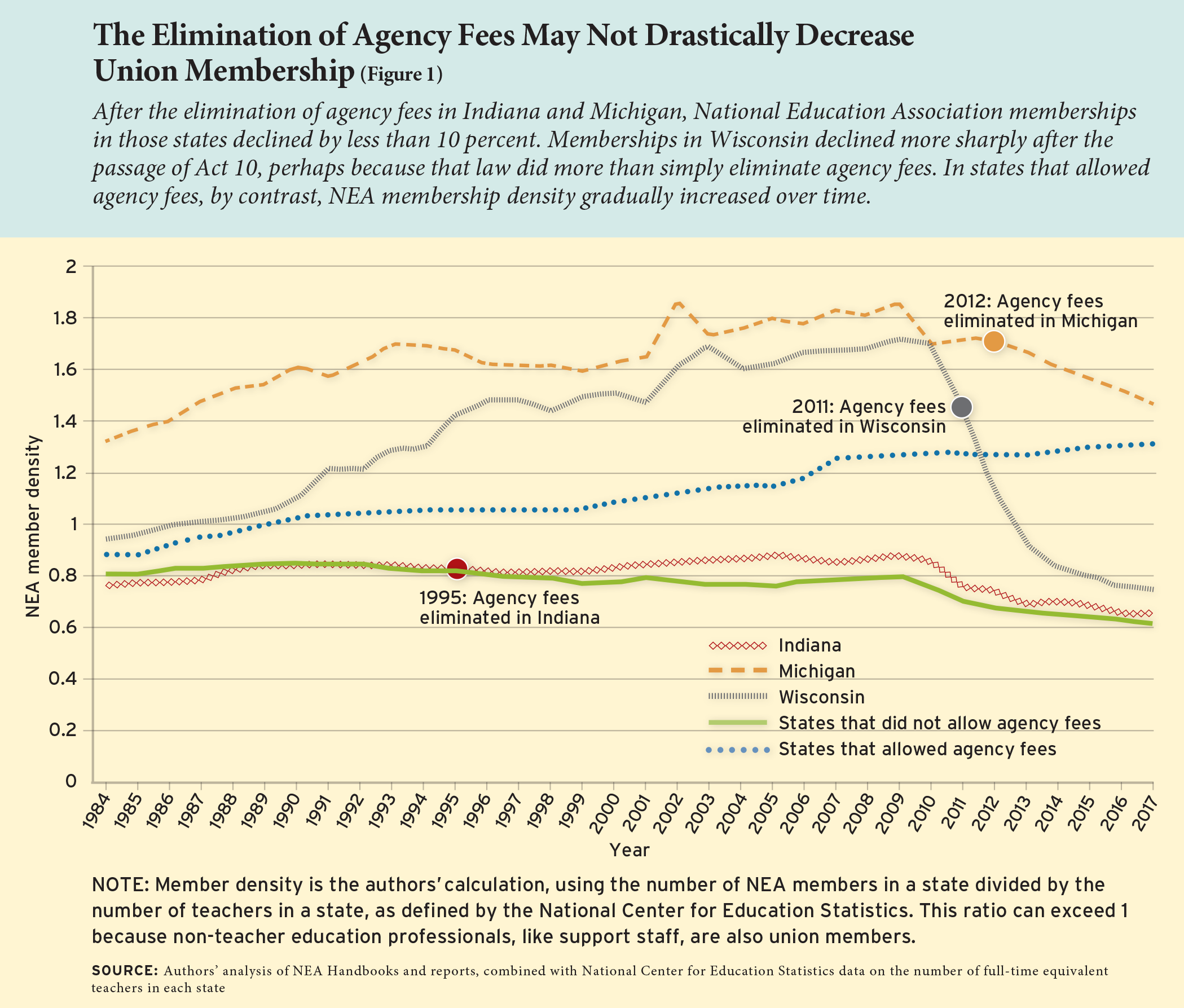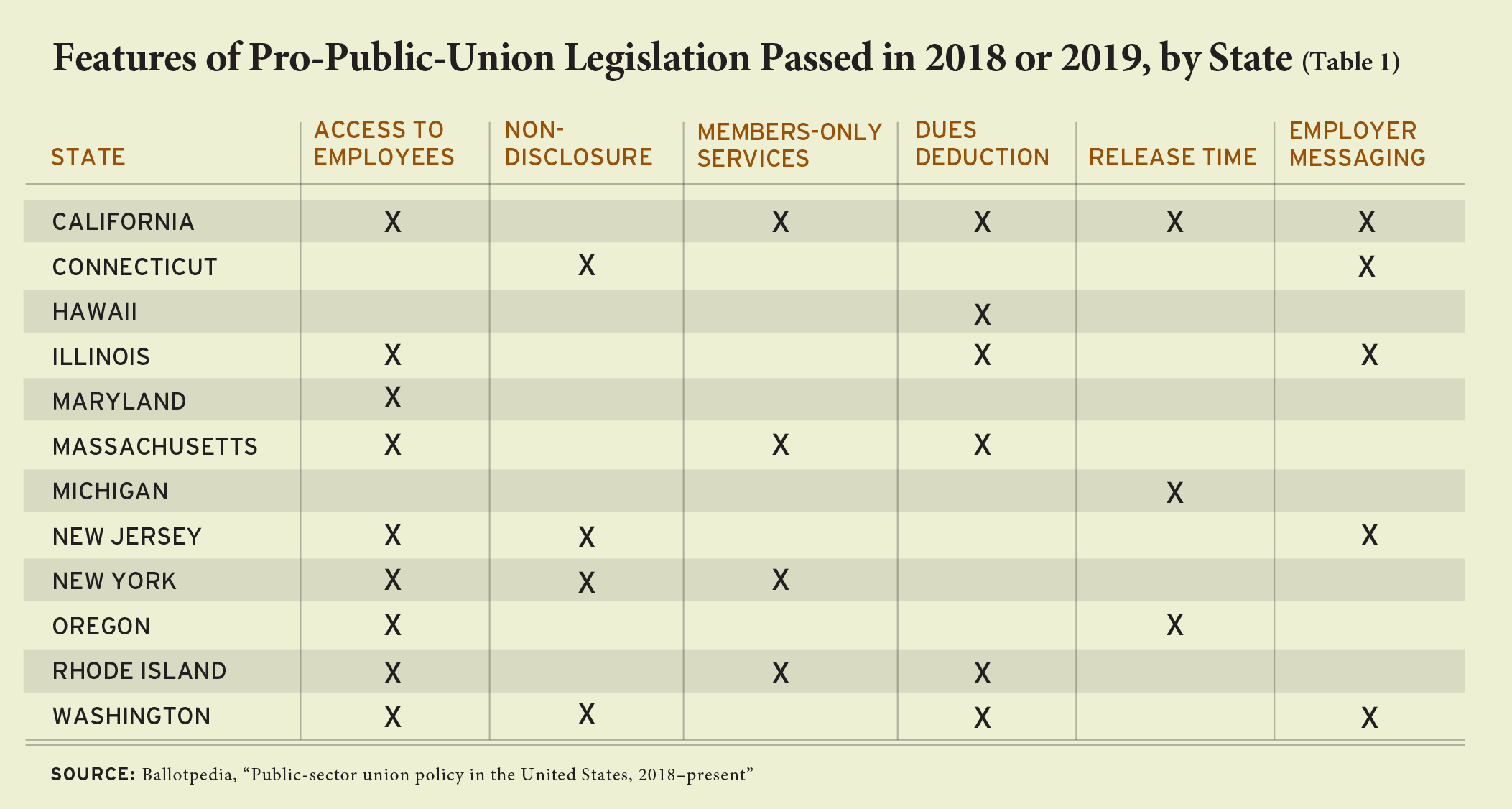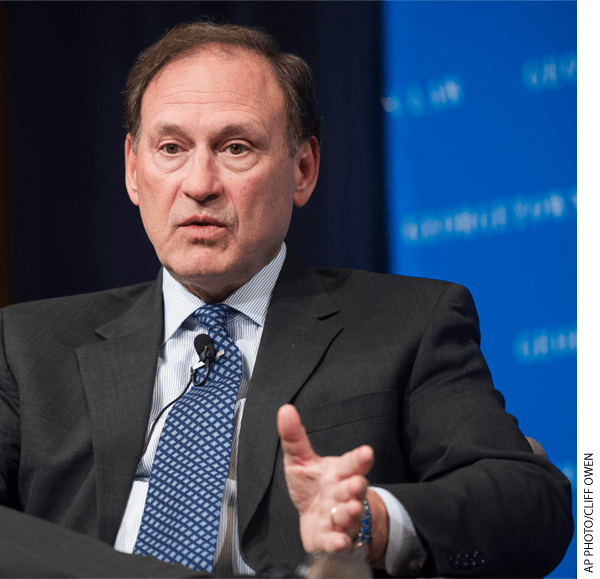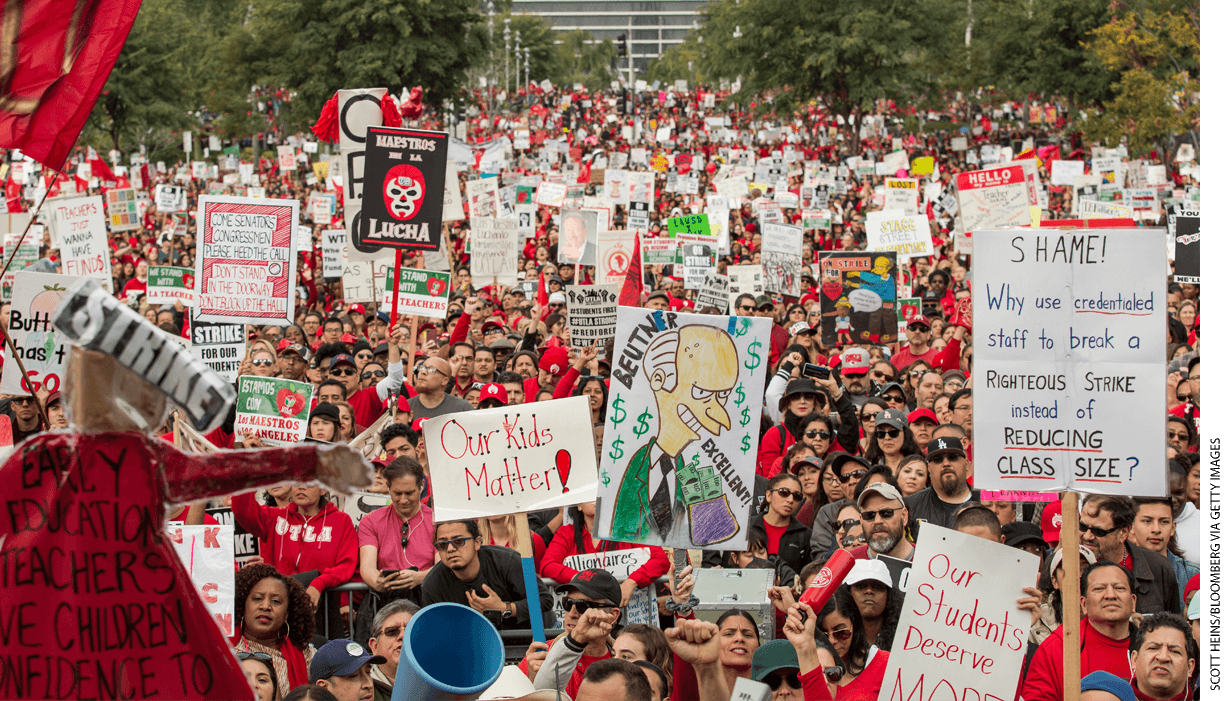
As school-district officials weigh whether and how to reopen schools this fall during the continuing threat from Covid-19, negotiations with teachers unions will pose a key challenge. Unions at the local level have already shaped districts’ remote-learning strategies during the shutdown, pushing back in some places against what they see as unfair demands on teachers trying to deliver instruction via videoconferencing. At the national level, leaders of the nation’s two biggest teachers unions warned in April that they would consider strikes and mass protests if schools reopen without adequate safety protections. Buoyed by a series of successful strikes in 2018 and 2019, the unions seem to be negotiating from a position of strength—which is perhaps surprising, in light of a June 2018 U.S. Supreme Court decision that dealt a serious blow to public-sector unions.
In Janus v. American Federation of State, County, and Municipal Employees, Council 31, the court struck down state laws requiring non-union-member public employees to pay “agency fees” to unions that are their “exclusive bargaining representative.” The reason, according to the five-justice majority: such laws violate the First Amendment rights of employees by “compelling them to subsidize private speech on matters of substantial public concern.”
The conventional view at the time was that the Janus decision would swiftly erode the political power of teachers unions. Once nonmembers were no longer compelled to pay unions’ agency fees, also known as “fair-share fees,” the unions stood to lose both fee revenues from existing nonmembers and dues money from members who decided to quit. With fewer members and less money, the reasoning went, teachers unions would lose clout.
That prediction has so far proven wrong. Janus has not led to a collapse in union finances or political power. Although the unions lost their agency-fee revenue and some members, the effects of Janus have to date been far less catastrophic than the apocalyptic scenarios predicted by union advocates. Data from the U.S. Bureau of Labor Statistics show only a 1 percent drop in local-government union membership from 2018 to 2019. Yet the court’s decision, along with new laws adopted in more than a third of the states that formerly allowed agency fees, have reshaped the political and policy environment of public education in the United States.
Union Clout
Prior to Janus, 22 states had laws that permitted agency fees. Among them were some of the nation’s largest and most populous states—including New York, New Jersey, California, Massachusetts, and Illinois—accounting for a majority of the nation’s teachers. The fact that teachers in these states had to pay fees to unions regardless of whether they joined provided a powerful incentive for teachers to sign up and pay full membership dues, especially since fees typically amounted to 80 to 90 percent of dues, or nearly $1,000 on average. The share of unionized teachers exceeded 90 percent in most of these states—and had been that high since the 1990s. More members meant more dues revenue.
Members and money translate into political power. Stanford University political scientist Terry Moe, a leading scholar of teachers unions, posited that the National Education Association and the American Federation of Teachers, with nearly 5 million members between them, constitute one of the “most powerful interest groups of any type in any area of public policy,” exerting influence on education policy at all levels of government. These unions shape education policy from the bottom up, through collective bargaining, and from the top down, through political activity.
Since 1990, the AFT and the NEA have regularly been among the top 10 contributors to federal electoral campaigns. They have forged an alliance with the Democratic Party, which receives the vast majority of their hard-money campaign contributions as well as in-kind contributions for get-out-the-vote operations. Teachers-union members regularly constitute at least 10 percent of the delegates at the Democratic National Convention, making them the single largest organizational bloc of Democratic Party activists. According to Moe in his book Special Interest, teachers unions were the number one hard-money contributor to federal election campaigns between 1989 and 2009, spending a combined $59.4 million—but even this impressive feat understates their influence in state policymaking.
At the subnational level, where most key education and public-labor policies are made, the unions are often in a league of their own. For example, data from New Jersey government records show that the New Jersey Education Association is by far the biggest political spender in that state. Jeff Brindle, executive director of New Jersey’s elections watchdog, the Election Law Enforcement Commission, notes that “when you combine NJEA’s lobbying and campaign spending, no single interest group has ever come close.” Similarly in California, New York, Illinois, and other states, the teachers unions are perennially at or near the top of the list of interest-group contributors to state politics in general and to the Democratic Party in particular.
Union Finances
Janus immediately affected the finances of the NEA and the AFT as both unions lost revenue from former fee payers—ranging from about 2 percent to 10 percent of teachers in the states that had permitted agency fees. On top of that, some members decided to opt out of the union and no longer pay dues. Any organization that loses such a significant portion of its annual revenue stream must adjust—and these were just the immediate losses. If membership continues to drop, so will union resources.
After Janus, the AFT lost 82,713 nonmember agency-fee payers from among the 1.7 million school employees it represents, resulting in a loss of some $18 million in annual fee revenue. The NEA reported a loss of 88,000 agency-fee payers out of 3 million represented workers. Consequently, the organization lost at least $32 million in fee revenue, amounting to about 10 percent of its annual budget. Part of the reason the loss of roughly the same number of fee payers yields such large differences in revenue declines for the two unions is that the AFT represents more non-teaching school employees and part-time employees, many of whom earn lower salaries than full-time teachers and pay proportionately lower fees.
The revenue losses have forced some noteworthy adjustments. In 2018, the NEA cut its annual budget by $28 million and laid off 10 percent of its staff. The association proposed cutting two days from its annual convention to save money, but the Covid-19 crisis later forced the union to switch to a “virtual” convention this year. The NEA has also slightly increased the cost of member dues. Finally, the association created a non-education-employee membership category—in essence allowing anyone who supports its agenda to join—in an effort to boost revenue. Meanwhile, the AFT has sought to expand its revenue base by recruiting retired teachers to become dues-paying members.
The loss of agency-fee revenue limits the funds available to pay for union political advocacy. Additionally, the unions no longer have this revenue to deploy for membership recruitment. To the extent that the fees helped subsidize these efforts in the past, Janus constrains union power and represents a significant change for union budgeting.
The key challenge for union finances going forward will be how to retain current members and recruit new ones. If more teachers and school employees opt out of union membership because under Janus they can now receive union representation free, this decline will depress union revenues even further.
Union Membership
Fortunately for the teachers unions, they have not experienced a major drop-off in membership to date. Some unions lost members, including the Oregon chapter of the AFT, whose membership fell 15 percent (to 7,681 from 9,085). In a few states, such as Oregon, membership losses were likely higher because of “opt-out” campaigns launched by think tanks and activist organizations. Yet other unions were able to increase membership slightly or hold it relatively steady by preventing current members from opting out.
The national AFT has noted on its LM-2 form—on which certain unions must report key financial and organizational information to the Department of Labor—that it has slightly increased membership among full-time employees and among retirees since the Janus decision but has lost members who are part-time workers or associate members.
Counting only active employees and not retirees, the union reported a 6.2 percent membership decline from 2018 to 2019. Meanwhile, the NEA reports 29,189 fewer members in 2019 than in 2018. However, most of that loss occurred because the 19,000-strong California Faculty Association disaffiliated from the NEA.

What might the future hold for union membership rates? Because three states eliminated agency fees prior to Janus (Indiana in 1995, Wisconsin in 2011, and Michigan in 2012) we can look there for guidance. Figure 1 displays NEA membership density for these states and for agency-fee and non-agency-fee states from 1984–85 to 2017–18. Historically, the loss of agency fees accompanied a membership decline of no more than 10 percent. Wisconsin, however, is an outlier because it did far more to diminish union power than simply eliminate agency fees. Act 10 also requires annual certification elections to determine whether a majority of workers in a bargaining unit want union representation. The law also limits the scope of collective bargaining to wages, which cannot be raised by more than the rate of inflation. Public unions found the certification elections costly and cumbersome. Bargaining also hardly seemed worth the effort, with the subjects of negotiation so limited. A number of unions converted themselves into associations that could lobby on workers’ behalf but no longer enjoyed collective-bargaining rights. In addition, more than half of the teachers unions in the state’s 446 school districts lost their certification elections and their legal positions as exclusive representatives entitled to bargain. They, too, changed themselves into associations without the legal right to bargain with government employers.
It is hard to say precisely why the elimination of agency fees through right-to-work laws did not diminish membership more sharply, especially since, in a 2020 survey by Educators for Excellence, nearly a quarter of teachers who were union members said they were considering opting out next year. However, a few likely factors include: a pro-labor culture in these states, older members’ resistance to change, employee indifference, and union organizing to retain members. Indiana is instructive. It lost agency fees in 1995 but saw no major drop until the law had been fully implemented and older teachers began to retire.
In sum, in the post-Janus world, the teachers unions are starting from a position of strength, and recent patterns suggest that defections will be modest and slow.
Union Federations
The loss of agency-fee revenue and of some members will likely change the financial calculus for the national federations of the AFT and the NEA. As noted above, the NEA has already cut its budget and staff. Yet the big change resulting from Janus is that the national federation will no longer be able to repurpose revenues from the strong-union states to those where the local teachers unions are weaker. Before Janus, the national federations could smooth the unevenness of local-union strength that resulted from variations in state laws by subsidizing weak unions in times of need.
In a forthcoming study in Perspectives on Politics, one of us (Hartney) looks at the NEA’s LM-2 reports and finds that teachers unions in states where such unions are weak rely on their national federation for financial support in tough times. However, as Janus now reduces the surplus revenue available to national federations, the unions’ ability to redistribute funds from stronger to weaker affiliates will diminish.

New Laws
One reason unions have been able to avoid catastrophe surely lies in the fact that Janus provoked a swift legislative response from unions’ political allies in the 22 affected states. Half of them have adopted new laws to bolster public-employee unions and shield them from the effects of Janus (see Table 1). This is a striking indicator that public-sector unionism differs from its private-sector cousin insofar as state governments—aka management—have promulgated laws to retain the strength of the unions they have to bargain with.
Teachers unions pushed their political allies in state government to enact laws to make organizing easier in a post-agency-fee world. Immediately after the Janus decision was handed down, the Center for American Progress, a liberal think tank that receives donations from the AFT, published a paper outlining specific reforms that state and local policymakers could enact to protect union organizing. In New Jersey, union president Marie Blisten lauded Governor Phil Murphy, a Democrat whose candidacy the union had endorsed, for signing the Workplace Democracy Enhancement Act. She called it a “real win for working people in New Jersey,” which “shows that New Jersey respects the value of [public-sector] unions and the right of employees to join together and advocate for the values that matter to them.” Among other things, the act mandates that employers give unions access to employees at orientation meetings or by ensuring union release time. It also requires that school districts, within 10 days of a teacher’s hiring, provide the union with the new employee’s contact information, including home or cell phone numbers.
Many state legislators have a lot riding on union finances, as they often rely on these labor organizations for campaign contributions and get-out-the-vote drives. Therefore, even without extensive union lobbying, many legislators in the states affected by Janus had reason to protect their allies from the full force of the court’s decision.

The new state laws variously provide four kinds of powers or protections to public-sector unions. The first provision relates to access to workers. Statutes in nine states now assure unions’ access to new employees so that advocates can make the case for union membership. These laws give the unions access to employees’ contact information and specify that union representatives can speak to new hires on the job.
A second provision of some of the new laws restricts communication by anti-union individuals and groups. In California, Washington, and New Jersey, it is now illegal for public employers to discourage union membership. In addition, some states have taken steps to prevent outside groups from contacting public employees to inform them of their new legal rights under Janus. Such provisions matter, because they mute the efforts of organizations that seek to run informational campaigns to convince employees to drop their union membership. The result is that the messaging environment in public employment in several states now has a strongly pro-union bias.
A third component of the laws makes union membership more attractive. Four of the new state laws stipulate that public-sector unions can offer services exclusively to members and limit those provided to nonmembers. Such provisions capitalize on a little-noticed part of Justice Samuel Alito’s majority opinion in Janus, stipulating that “individual nonmembers could be required to pay for [a] service or could be denied union representation altogether.” For example, New York State United Teachers has stripped the employees it represents of the life insurance, eye and dental coverage, and other benefits it provides unless workers join the union. Similarly, Massachusetts now allows public unions to charge nonmembers for representation in grievance and arbitration cases. To receive such legal services, workers would need either to join the union or pay for a private attorney. Such provisions encourage existing members to remain in the union and offer an attractive recruiting tool to enlist new members.
The fourth piece is aimed at maintaining membership. A number of states have enacted or allowed measures that make it more difficult for union members to revoke their membership. New policies, sometimes enshrined in union cards, specify annual windows of time when workers can opt out of membership—usually the 10 days following the anniversary of the employee’s hiring date—and the detailed steps they must follow to do so. In some cases, workers can leave the union at any time, but dues are still deducted from their paychecks until the opt-out time rolls around. The state of Washington recently reset rules for dues deductions from a worker’s paycheck: an employee can easily authorize deduct ions—by email, over the phone, or by letter—but can only discontinue them by means of a formal letter to the union.
In the wake of Janus, which stripped public unions of the right to require all represented workers to share the costs of collective bargaining, the obvious aim of these laws is to help public unions grow and maintain their memberships. One cannot predict the total effect of these measures, but to the extent that they achieve their aims, they will keep union membership higher in the states that have adopted them. The unions are already capitalizing on these legal changes. The NEA, for example, recently released two publications highlighting the importance of securing a place for the union on the agenda at new employee orientations, having access to member information and communications platforms with members, securing release time for association business, and dues deductions.

Teacher Strikes
It is probably not a coincidence that public-school teachers began engaging in strikes and work stoppages soon after the Janus decision was handed down. In 2018, teacher walkouts occurred in the Republican-leaning, weak-union states of Oklahoma, Kentucky, Arizona, West Virginia, North Carolina, and Colorado. Of these, the largest work stoppage was by the Arizona Education Association and involved 81,000 teachers. The second-largest strike, by the Oklahoma Education Association, included 45,000 teachers. Overall, the 20 major teacher strikes of 2018 involved the highest number of workers—485,000—since 1986.
Aside from forcing local workplace issues to the bargaining table, strikes can also serve as a union recruitment and retention strategy. Calling a strike enlists the rank-and-file in a collective enterprise and thereby enhances union solidarity. Because only union members can vote to authorize a strike, union leaders can use such occasions to recruit nonmembers to join. Strikes also gain teachers unions sympathetic national press coverage.
In 2019, a smaller wave of strikes occurred in Democrat-dominated, strong-union cities, including Los Angeles, Oakland, Denver, and Chicago, as well as in a number of smaller school districts in Oregon, California, and New Jersey. Prior to 2018–2019, only two notable teacher strikes had occurred in big cities in the past 20 years: a 7-day walkout in Chicago in 2012 and a 16-day walkout in Detroit in 2006.
Besides pay, a major point of contention in these strikes was the demand that school districts hire more teachers to reduce class sizes and employ more support staff. Regardless of whether such measures make wise policy, they clearly serve to increase the pool of potential union members. Consider that, in Los Angeles, the district and the union settled on a deal that added 300 nurses, 82 librarians, 77 counselors, and some new teachers to reduce class sizes. In Chicago, the district and the union settled a five-day strike with a contract that included caps on class sizes, which necessitated adding more teachers, and promises to hire 250 nurses and 209 social workers. All of these new employees are potential union members.
There is evidence that teachers-union activity post-Janus did increase solidarity. A survey by Educators for Excellence found that 54 percent of teachers in 2020 felt that union membership provided them with “feelings of pride and solidarity,” up from 46 percent in 2018. In addition, a little more than half of teachers who do not belong to the union say they are likely to join their union next year.
The strikes have also increased public support for the teaching profession. Although a vigorous debate persists among analysts, it is now the popular wisdom that teachers are underpaid. West Virginia and Arizona both ended teacher walkouts by passing across-the-board pay increases. Early in the current presidential campaign, some Democratic candidates proposed using federal funds to top up teacher salaries. Public opinion has notably shifted in favor of increasing teacher salaries. The 2019 Education Next survey found that, among respondents who were not told the average salary of teachers in their home state, 72 percent said teacher pay should increase, while just 3 percent favored cutting it. Even among respondents who were told how much teachers currently make, 56 percent favored hiking these salaries—a 20 percent increase since 2017—and only 5 percent wanted to decrease them.
Beyond pay, one study found that the recent strike wave increased support for teachers unions. The survey found that parents of school-age children with firsthand experience with the recent strikes supported greater legal rights for teachers unions and favored a stronger labor movement. This is a notable finding, given that teacher work stoppages make life difficult for parents, who must scramble to find childcare and things for kids to do.
In short, the teachers unions have gained public sympathy, while education reformers have lost some. Consider the cover of Time magazine at the dawn of the education-reform movement in 1980: “Help! Teacher Can’t Teach.” Forty years later, in the aftermath of the Great Recession and red-state teacher strikes, Time once again put the image of a schoolteacher on its cover, but the headline told a different story: “I have a master’s degree, 16 years of experience, work two extra jobs, and donate blood plasma to pay the bills. I’m a teacher in America!”
Party Politics and Education Reform
Even without agency fees, many state laws still organizationally support teachers unions and encourage their members’ political activity. Supports include encouraging employees to join unions, government-employer collection of union dues, and allowing the use of workplace resources for union business. In addition, government employers often grant paid release time for the local union president to conduct union business, essentially underwriting that officer’s political activity.
Add all that to the fact that most teachers hold favorable opinions of their local union and are likely to remain dues-paying members, and you have a recipe for the persistence of union power in the education sector. Janus has clearly dented that power, but it has hardly destroyed it. Given how dominant the teachers unions were in many jurisdictions prior to Janus, their relative decline will still leave them at or near the top of the political heap.
At the same time, the unions’ main adversaries appear to be in disarray. Since the late 1980s, a bipartisan education-reform movement has sought to improve the performance of America’s public schools. The movement’s axioms are accountability and choice. Accountability means rigorously evaluating teachers, linking pay to performance, and getting low-performing teachers out of the classroom. Choice means introducing competition into American public education in the form of charter schools or vouchers that help students attend private schools.
Today, however, many Democrats have stepped back from ideas and themes of the reform movement. Vouchers, charters, student testing, merit pay, and teacher evaluations have come under increased scrutiny. Democratic presidential hopefuls Elizabeth Warren and Bernie Sanders led this shift, calling for the elimination of federal funding for charter schools. Yet there remain pockets of Democratic support for reform in many blue states, and former vice president Joe Biden, the presumptive Democratic nominee, has opposed for-profit charters but not all charters. Meanwhile, Republicans have continued to back parts of the reform agenda, but these items are no longer high on their list. Bipartisan efforts toward robust K–12 education reform in Washington appear to be running on fumes. In some states, Democrats and Republicans still cooperate on education-reform issues, but education policy at the national level has mostly polarized along party lines. Gone are the days when elements of both parties supported initiatives such as No Child Left Behind and President Barack Obama’s Race to the Top program.
While labor-management issues have long divided Democrats and Republicans on ideological grounds, both parties now have strong political incentives to shape the status of teachers unions for good or ill. Disputes about labor law were once more under the radar and technocratic. No longer. Democrats increasingly see stronger teachers unions as essential to their fortunes at the ballot box. Republicans see matters in the same light and believe that weakening these unions is not only good policy but good politics, too.
Most likely, the future of education politics will see teachers unions persisting as major players in a handful of heavily Democratic states—including California, Connecticut, Illinois, Massachusetts, New York, and New Jersey—but soldiering on as diminished forces elsewhere.
Daniel DiSalvo is professor of political science at the City College of New York-CUNY and a senior fellow at the Manhattan Institute. Michael Hartney is assistant professor of political science at Boston College.
This article appeared in the Fall 2020 issue of Education Next. Suggested citation format:
DiSalvo, D., and Hartney, M. (2020). Teachers Unions in the Post-Janus World: Defying predictions, they still hold major clout. Education Next, 20(4), 46-54.


